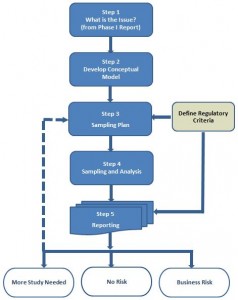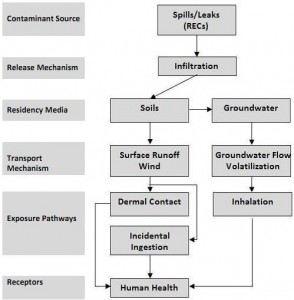In last week’s blog post, I discussed issues related to Phase I Environmental Site Assessment (ESA) in developing countries. This week I’ll explore some of the issues in carrying out a Phase II ESA, and in particular how to carry out the Phase II ESA when there are no local regulatory soil and groundwater remediation criteria.
Let’s begin with an overview of the Phase II ESA process.
Phase II ESA
As we discussed last week, a Phase II ESA is done after a Phase I ESA concludes that there is potential for contaminated soils or groundwater to adversely affect human health or the environment, at the subject property and/or offsite. ASTM E1903 Standard Practice for Environmental Site Assessments: Phase II Environmental Site Assessment Process is one of the most widely used protocols for Phase II ESA.
Regardless of which protocol is used the steps are more or less the same. The Phase II ESA process is relatively straightforward, but, that does not mean it is simple to execute effectively. Each step requires considerable expert judgement combined with consideration of certain prescriptive elements as summarized below:
 Step 1: What is the Issue?
Step 1: What is the Issue?
The issue is defined from the findings of the Phase I ESA, e.g., underground fuel tanks or improper storage of hazardous substances that either in the past or present were or are potentially leaking toxic substances into the underlying soils.
Step 2: Conceptual Model
A conceptual model is developed to illustrate how the toxic substances may interact with people and/or the environment. The model typically describes the source of the contaminants (e.g., fuel in the underground storage tanks), expectations as to how the contaminants may be released into the environment (e.g., leaks from the tank), potentially affected media (e.g., soils and groundwater), transport characteristics of the contaminants (e.g., infiltration, groundwater transport), fate of the contaminants (e.g., volatilization of benzene), and interaction with receptors (e.g., people in nearby buildings that might breath benzene vapors or drink groundwater contaminated with benzene). An illustration of a conceptual model is shown below:
Step 3: Sampling Plan
A sampling plan is developed to collect field data to test the conceptual model, e.g., sample soils, groundwater, air from specific locations at the site to confirm presence or absence of benzene at levels above regulatory criteria.
Step 4: Sampling and Analysis
The field sampling program is carried out and laboratory analyses conducted as per the sampling plan.
Step 5: Reporting
A written report is prepared that includes among other sections a detailed presentation and discussion of all data collected, interpretation of the findings with respect to the objectives and conceptual model, conclusions and recommendations. Typically the Phase II ESA report will lead to one or more of the following conclusions:
- Additional Study – This is not an uncommon conclusion, particularly if the Phase II study has been carried out in a staged-manner in an attempt to save time and/or money, e.g., first collect shallow soil samples and proceed to groundwater sampling only if elevated contaminant levels are detected in the soil samples.
- No Risk – In this case, most or all samples will have contaminants levels below the appropriate regulatory criteria.
- Business Risk – A case for a business risk will be made when some or all samples contain elevated levels of contaminants at levels above regulatory criteria and that these occur over a significant area/volume to pose a serious environmental liability to the company. At this stage, the client will typically request the consultant prepare a remediation plan and cost estimate to remedy the situation.
Each step in this process has its own technical challenges. However, the one issue that is most often raised by my clients in developing countries and has the most nuances and has ramifications at all stages of the Phase II ESA is related to remediation criteria. As shown in the process flow chart above, remediation criteria are needed both during the sampling design phase and also when interpreting the findings of the study.
How then can we assess whether a site is “contaminated” or not when the local jurisdiction has no soil or groundwater standards/criteria for remediation?
We’ll deal with this by first making sure we understand what we mean by remediation criteria.
What Are Remediation Criteria?
Simply stated, remediation criteria are the levels of substances that are deemed to be unsafe or unacceptable in a specific media. Typically, in western countries remediation criteria are set by regulatory authorities for substances in soils and groundwater, and these can vary based on different land-use scenarios
For instance, the Province of Alberta in Canada has a two-tiered system. Tier 1 guidelines are generic guidelines for application at a range of sites within a given land use. Tier 2 guidelines describe how to develop site-specific guidelines by modifying the Tier 1 guidelines using site-specific information. Tier 1 guidelines are broken down into several sub-categories based on soil type (fine or coarse) and land use (natural areas, agricultural, residential/parkland and commercial/industrial) – remediation guidelines for benzene range from 0.046 to 0.078 mg/kg in soils depending upon the land use and soil type. If benzene levels at a site exceed those values, then you the criterion can be modified as per the Tier 2 guidelines by taking into account site-specific conditions.
Each jurisdiction typically had developed their own set of remediation criterion. For example, the Dutch standards for benzene in soils range from a target value of 0.01 mg/kg to an intervention value of 1.1 mg/kg. USEPA has established screening levels for benzene in soils from residential (1.2 mg/kg) and industrial (5.1 mg/kg) land use settings.
How to Define Remediation Criteria in Developing Countries? (How Clean is Clean?)
While there are certainly exceptions, I have found that there is typically little concern from local regulators about what specific remediation criterion is used, as long as it is from an international source. So, one can pick a guideline that is most consistent with the situation at the study site. Or, you can select one that is favored by the client, e.g., most US-based multinationals tend to want to follow USEPA guidelines. One additional suggestion is to keep the approach relatively simple. For instance, site-specific risk based criterion based on highly technical risk-based models are a challenge to explain and you should avoid complexities where possible. You will be better served if you can base your remediation criteria on a number in a table published by a credible source.
The question of what remediation criteria to use is also often followed-up with a questions from the client related to whether and/or how to report the situation to the regulators.
There is no one-size-fits-all response to this question. But, if I were to generalize what I most often tell my clients in such a situation is that first and foremost consider that you are on your own. Do not expect guidance from the local regulators. Be well aware of the local regulatory requirements for reporting and follow-up as required, noting that there is often vague wording in most developing country’s environmental laws pertaining to reporting of “spills”, “pollution” and “contamination” to the local authorities.
If the client chooses to report the situation to the authorities, then it is generally best to approach them after a credible solution to the issue has been defined or in some cases even after remediation of the site has been completed. What does a solution to the problem entail? For me, this means at the very least identifying/developing (1) credible remediation criteria, (2) a proposal for clean-up at the site, and (3) a plan and schedule for implementing the clean-up.
Whatever the strategy, remember that in most cases local regulatory personnel will have little or no experience with remediation so they are not typically in a position to provide guidance for a Phase II study. At the same time, I typically find the local environmental regulators extremely enthusiastic and helpful and even grateful that someone has made an effort to address their problem and provide them with an opportunity to participate in the solution.
Good luck! And finally, if you need help with a Phase I or II ESA please feel free to contact us.
Thanks for reading. Keep safe. Be healthy. Respect your environment.
I hope that you will bookmark the blog, share it with your colleagues and visit the blog frequently because you find it informative and helpful. I value your feedback and suggestions for future topics.
Please enter your email in the box at the top of the post and subscribe to our blog HSE Asia – our weekly blog will be emailed directly to you.
Next Week’s Blog Topic: H&S, OHS, HSE, HSSE, HSEQ, HSE/CSR … Alphabet Soupization
Photo Credits: Vacuum cleaner photo courtesy of Merelize at freerange.com


Great summary write up.